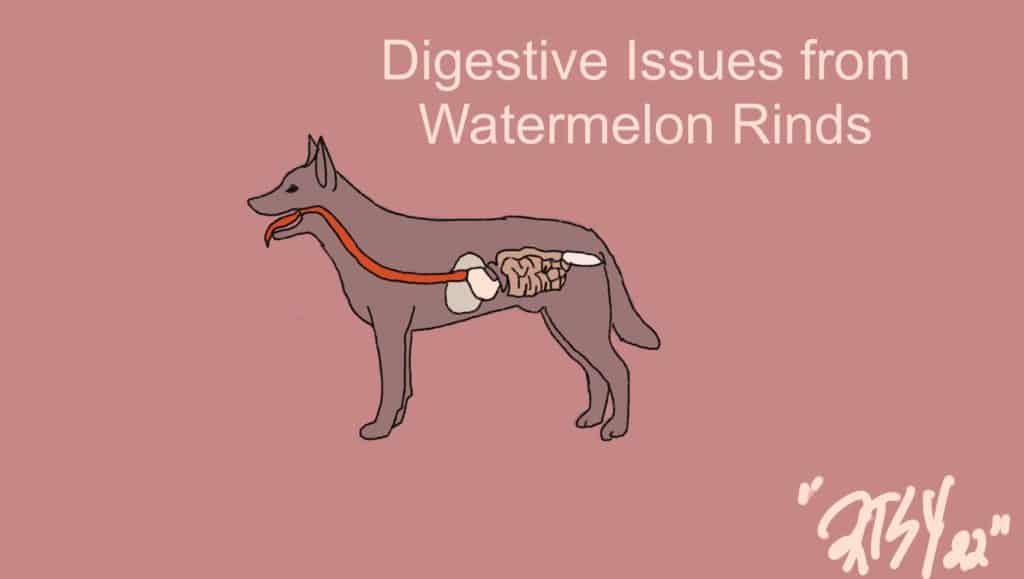So, you’ve suddenly noticed that that watermelon rind you had left over on the counter is gone … and your dog is staring up at you with red lips and a wagging tail. He just ate the watermelon.
And you’re wondering: “Can dogs have watermelon rind?”
As usual, the answer is not so simple. Let’s take a look.
Table of Contents
Can Dogs Have Watermelon Rind?
Yes and no.
For most dogs, watermelon rind is not going to pose a problem. And certainly, the pink watermelon flesh itself should be fine for most dogs to eat.
The rind of watermelon is not the problem for dogs in and of itself. That is, it’s not toxic. When watermelon rind does become an issue, it’s usually because the dog has eaten too much of it or they haven’t chewed it enough.
As with any food, dogs need to eat in moderation just like humans. If, for some reason, they were to eat an entire watermelon rind, for example, this may be an exceedingly high amount of fiber, which can cause gastrointestinal symptoms such as discomfort, diarrhea, constipation, or vomiting.
The other issue could be the texture of the watermelon rind. Some dogs have a habit of “inhaling food”. They don’t chew very well, in other words.
So, if a dog were to “inhale” some watermelon rind, the tough, sharp edges may cause physical discomfort in their mouth and throat. These pieces may also be difficult for your dog’s digestive system to process.
Gastrointestinal upset basically means having digestive issues or a “tummy ache”. So, most of the signs associated with the same plight in humans (pain, lethargy, gas, vomiting, diarrhea, etc.) are also going to be noteworthy signs in dogs. Watch out for these first and foremost.
Signs of Gastrointestinal Upset in Dogs
Gastrointestinal upset basically means having digestive issues or a “tummy ache”. So, most of the signs associated with the same plight in humans (pain, lethargy, gas, vomiting, diarrhea, etc.) are also going to be noteworthy signs in dogs. Watch out for these first and foremost.
Of course, dogs are similar to humans, but not the same. Therefore, dogs may also show additional signs of stomach upset.
All in all, if you’re worried about a dog who has eaten watermelon rind, you’re going to want to keep an eye out for the following.

Symptoms of Digestive Issues in Dogs:
- Tiredness, lethargy
- Appearance of being in pain (may moan, groan, or hunch)
- Restlessness or inability to get comfortable
- Lack of appetite (not drinking or eating)
- Increased gas
- Diarrhea
- Vomiting
- Constipation
- Dehydration
- Distension (enlargement) of the belly
- Fever
In most dogs with stomach troubles, you won’t see all of these symptoms. Rather, you’ll notice one or two, and some may come and go. Anything out of the ordinary for your dog is notable.
Keep a record of any symptoms on a pad of paper with the date, time, and duration noted. This may be useful for your veterinarian if you end up seeking their help.
How Long Should You Watch for Symptoms?
Make sure you watch for signs and symptoms of gastrointestinal distress in your dog for at least one week after they have eaten the watermelon rind (or any other suspect food like corn starch or substance). Keep a special eye on them for the first one to two days as this is usually when symptoms will initially show up.
What Should You Do if You Notice Symptoms?
Let’s say your dog has eaten some watermelon rind, so you’ve been keeping an eye on them, and now you’ve noticed some of the gastrointestinal signs outlined above. What should you do?
Well, you have a few options.
1. Call your vet.
“Better safe than sorry”. If you’re especially worried about your dog, don’t hesitate to call your vet right away. Some dogs who are health-compromised or of an older age may be at heightened risk for complications. Puppies, also, may need immediate care.
In these cases, it’s good to be on the safe side.
You should especially call your vet right away if any of the more serious symptoms are present:
-Your dog is so tired that they are unresponsive and you can’t rouse them
– They will not eat or drink
– Their diarrhea or vomiting is bloody
– Their diarrhea or vomiting is severe and doesn’t stop
– They have extreme symptoms of bloating, which could be a sign of GDV (gastric dilatation and volvulus)
2. Withhold food.
Whenever your dog has suspected gastrointestinal problems, you should be sure to withhold food for at least 12 to 24 hours after you begin to notice symptoms. Like humans, the digestive system can become irritated, and putting additional foods into it can cause even more severe problems and distress for your dog.
Start by withholding food and only providing water or ice (see next tip) for 12 hours after the first symptoms start. If your dog appears to have improved after this time, try giving them a smallamount of simple food.
If symptoms reappear, go another 12 hours of withholding food (continue to provide small, frequent fluids to avoid dehydration). If symptoms continue beyond this point or become worse at any time, call your veterinarian.
3. Provide ice cubes.
Like humans, dogs need to stay hydrated — even when they’ve been vomiting or experiencing diarrhea and are having trouble keeping food and drink down.
The best solution here is to provide ice cubes for your dog. You don’t want to give them too much liquid, and it can be difficult to know how much a dog is slurping down when they drink normally from a dish, so ice cubes also serve the purpose of better water intake monitoring.
Start by giving your dog a small amount of ice cubes in a low tray or bowl. After a few hours, give them a bit more, and continue to increase the amount if they are able to keep the ice down.
Again, vomiting and diarrhea can instantly cause dehydration, so you’ll need to continue providing ice throughout the duration of their stomach upset. If these symptoms continue without abatement or get continually more severe, call your veterinarian.
4. Try canned pumpkin.
Believe it or not, canned pumpkin is a great “sick meal” option for dogs who have an upset tummy with mild symptoms. Just be sure to get 100% pumpkin and not a pie mixture.
This is a food that most dogs will love, but because of its low glycemic index, it is slowly absorbed into the body and can aid in repairing digestion.
When feeding canned pumpkin to a dog with tummy troubles, don’t give them the whole can. Larger dogs over 75 lbs. (or thereabouts) can have one tablespoon of canned pumpkin. Little dogs should only have one-half teaspoon.
In the end, while watermelon flesh is a yummy summer treat for dogs, watermelon rind may not be the best snack! If, however, your dog does consume watermelon rind, use the advice above to know what to do.

